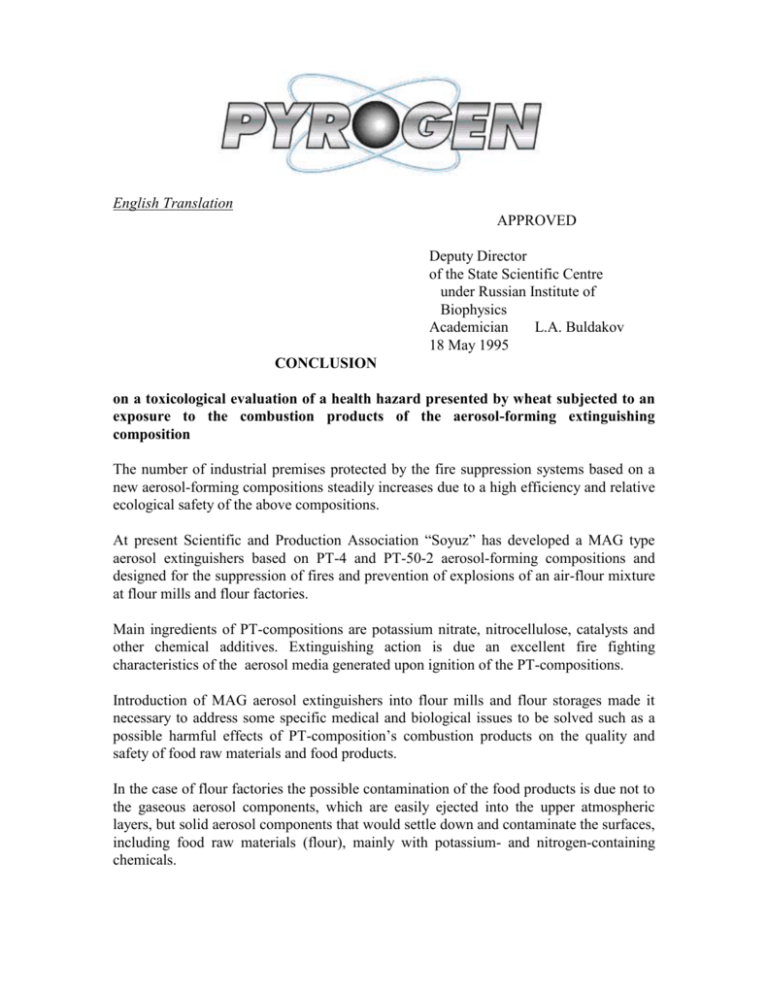Grain system approval
advertisement

English Translation APPROVED Deputy Director of the State Scientific Centre under Russian Institute of Biophysics Academician L.A. Buldakov 18 May 1995 CONCLUSION on a toxicological evaluation of a health hazard presented by wheat subjected to an exposure to the combustion products of the aerosol-forming extinguishing composition The number of industrial premises protected by the fire suppression systems based on a new aerosol-forming compositions steadily increases due to a high efficiency and relative ecological safety of the above compositions. At present Scientific and Production Association “Soyuz” has developed a MAG type aerosol extinguishers based on PT-4 and PT-50-2 aerosol-forming compositions and designed for the suppression of fires and prevention of explosions of an air-flour mixture at flour mills and flour factories. Main ingredients of PT-compositions are potassium nitrate, nitrocellulose, catalysts and other chemical additives. Extinguishing action is due an excellent fire fighting characteristics of the aerosol media generated upon ignition of the PT-compositions. Introduction of MAG aerosol extinguishers into flour mills and flour storages made it necessary to address some specific medical and biological issues to be solved such as a possible harmful effects of PT-composition’s combustion products on the quality and safety of food raw materials and food products. In the case of flour factories the possible contamination of the food products is due not to the gaseous aerosol components, which are easily ejected into the upper atmospheric layers, but solid aerosol components that would settle down and contaminate the surfaces, including food raw materials (flour), mainly with potassium- and nitrogen-containing chemicals. Health hazard of the flour that had been contaminated with PT-4 composition’s combustion products at concentrations adequate to those applied in real situations (100 g/m3) was determined by conducting the following experiments: 1) Investigation of the organoleptic characteristics of the “contaminated” flour and grain products baked from it; 2) Chemical analysis of the “contaminated” and “pure” controls samples of wheat flour as provided by the client - Scientific and Production Association “Soyuz”; 3) Toxicological experiment on animals of different age groups subjected to a 30-days feeding with the grain products baked from the “contaminated” and “pure” flour. Results of the above research showed the following: - Appearance of the “contaminated” flour differed from that of “pure” flour - a surface layer of the flour, subjected to the contamination with PT-composition’s combustion products, was of gray color disappearing when mixed with deeper layers. “Pure” flour was of normal write color. - Grain products baked from the “contaminated” flour had an alien weak odor. - “Contaminated” flour had higher compared to “pure” content of potassium ( 2400 mg/kg in the upper layer and 1400 mg/kg in the mixed “contaminated” flour, this being compared with 1040 mg/kg for the “pure”); nitrates - ( 10 mg/kg in the mixed “contaminated” flour compared to 3.4 mg/kg for the “pure” flour); and nitrites - (0.31 mg/kg in the mixed “contaminated” flour compared to 0.048 mg/kg for the “pure” flour). It was impossible to evaluate a health hazard of the detected higher levels of the above chemicals in the “contaminated” flour by referring to a standard maximum permissible concentration values, since those values had not been found in the official register of the USSR Health Ministry “Medical, biological and sanitary standards for the quality of food raw materials and food products” (State Standards, Moscow, 1990). However, test results on potassium could be compared with the reference data on permissible daily intake by human body quoted as a 3300 mg/day. The comparison led to a conclusion that a consumption of bread baked from the “contaminated” flour ( 0.3-0.5 kg/day potassium content) presented no health hazard for a human. Similar comparison on the quantities of the other chemicals ( nitrates, nitrites) detected in the “contaminated” flour resulted in the same conclusion of their harmlessness. Test results of the toxicological experiments on animals (results included a variety of integral, haematological, biochemical and morphological parameters) confirmed the above conclusion of harmlessness of the flour contaminated with PT-composition’s combustion products. Examination of adult test animals in comparison with control animals, that had been fed with bread made of “pure” wheat, revealed no definite changes in each parameter. Tolerances were within physiological norms and did not differ from the control figures. Young animals having higher susceptibility towards toxins showed by the end of 30-est day an activation of the alanintransferaza enzyme and insignificant increase in the value of liver’s mass coefficient that is a characteristic symptom for the adaptive mechanisms tension. Methemoglobinemia as a specific limiting factor for nitrates and nitrites effect was not observed. Based on the results of the tests on animals, the following conclusion could be drawn: Adult animals when fed with the grain products baked from the “contaminated” flour showed no symptoms of alimentary toxicosis, while the young animals fed with the same products showed tension of the adaptive mechanisms, however, without developing any of the pathologic reactions. Therefore, food raw materials (flour) and food products ( grain products) manufactured from flour contaminated with the combustion products of PT-composition present no health hazard for an adult consumer, but do not comply with the sanitary standards for the organoleptic characteristics - flour has a gray color and grain products - alien weak odor. Based on the undertaken research, the following recommendations for use of flour subjected to exposure of the aerosol combustion products of PT-composition are being suggested: - Remove upper “contaminated” layer until flour of a commercial grade appears ( visual control); - Use “contaminated” layer for technical purposes or in animal food; Flour of a commercial grade is permitted for use as a food raw material without any additional control. Head of the Toxicology Department V.S. Kushneva Accreditation Certificate for the Department: Registration No: CA 13.30 Date of issue: 1.12.93 Issued by: State Committee of Sanitary and Epidemic Inspection








